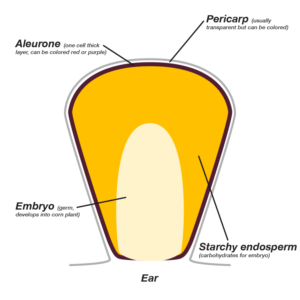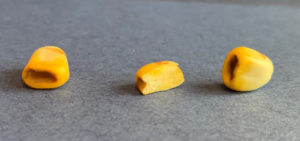Causes of Kernel Discoloration
From time to time, growing seasons can produce corn with ears exhibiting some colored kernels. Colored kernels can result from several internal and external causes. Sometimes darkened kernels appear as the result of diseases, such as fusarium, and a starburst pattern of whitish-pink, moldy discoloration appears on a kernel. However, if the kernels in question lack the color and pattern of fusarium or other fungal infections, the diagnosis points toward other non-disease influences.
Wheat curl mite feeding triggers red streaking within pericarps of otherwise yellow kernels. This is usually most noticeable near field borders, particularly wheat fields. Red streaks do not necessarily signify toxins, ear molds, or grain quality issues. In white corn, purple kernel streak has been documented as triggered by cold temperatures late in the grain filling period.(1)
Late-season stink bug damage can cause dark colored kernels. Stink bugs feed on developing tissues and can pierce husk leaves to inject kernels with enzymes. Enzymes help stink bugs dissolve tissue and suck up pre-digested plant fluids with their stylet mouth parts. Damage from stink bugs is more likely near field edges and in no-till fields.(2) Stink bug damage may be partly concentrated on the outer half of ears. Once kernels become too hard to pierce, stink bugs move on into soybean or other host plants that have developing seeds. In fall, live stink bugs may not be found in the affected corn fields as they have likely moved to nearby soybean fields and then to overwinter into wooded and grassy cover. Late-season kernel feeding is not expected to reach economic levels, and thresholds for control are not developed for late-season corn fields.
Differences in kernel appearance can be the result of gene expression similar to the non-disease lesion mimic. Corn has unique fertilization with pigmentation of aleurone layer and pericarp determined by the father and mother, respectively. Position of particular genes can randomly “jump”, and “jumped genes” become evident when they influence pigmentation.(3)
A side-split view of a corn kernel reveals four main parts: embryo (germ), endosperm, aleurone, and pericarp (Figure 1). Depending on the genetics of the corn product, the pericarp and aleurone layers can individually express purple, red, bronze, or white/clear coloration.

Figure 1. Kernel color can be influenced by genes. Pericarp color comes from the maternal parent and aleurone color is from the paternal parent.
Yield Effect
Fields with colored kernels are expected to have normal yields. Kernels are considered damaged when the embryo is affected. Observations of colored kernels does not mean unhealthy embryos. Stink bug damage occurring early in the season can affect corn stands; however, sporadic, late-season damage is not expected to affect grain yield or quality. Cool weather can affect pigmentation, and longer grain fill periods can benefit yield potential.(4)

Figure 2. Although some ears may exhibit more colored kernels than others, overall quantity in samples or loads at the elevator tend to be diluted and less apparent. This ear was examined at North Dakota State University to rule out stink bug and wheat curl mite damage. Colored kernels were assumed related to genetics in this field.
Grade Grading Considerations
In the past, elevators have accepted this type of kernel coloration because grain is still considered good quality, and disease-free grain with colored crowns has not been discounted as damaged. An official grade by a grain inspection agency can be requested if the ‘house grade’ by an elevator counts colored kernels as damaged. While each elevator is different, an undamaged germ (embryo) is what matters when grading grain (Figure 3).

Figure 3. The coloration of these kernels does not extend into the endosperm or affect the embryo, and discounts are not expected at the elevator.
There are three classes of corn: yellow corn, are not expected at the elevator. white corn, and mixed corn. Corn classified as ‘Yellow’ is yellow-kerneled and contains no more than five percent of corn of other colors. A slight tinge of red is still considered yellow corn. White corn is white-kerneled with no more than two percent of corn of other colors. A slight tinge of light straw or pink color is considered white corn. Mixed corn is corn not meeting the above standards or white-capped yellow corn.5 These classifications may be important for food-grade corn; however, a kernel needs to be greater than 50% colored to be considered ‘corn of other color’.
In the ethanol industry, purple pericarp corn was introduced to mark loads of corn intended with an ethanol end use. These purple plants are intentionally grown within fields for visual tracking. Purple-colored pericarps are removed from kernels in ethanol processing.
Conclusion
Field scouting for insects and disease helps manage fields and schedule harvest order. There are several color possibilities considered safe and do not affect quality or end use. Disease-free kernels with slightly discolored crowns are not expected to be discounted at elevators.
